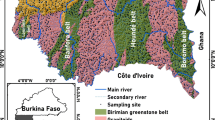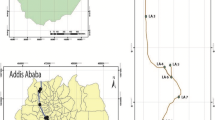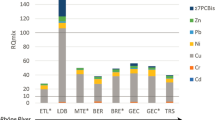Abstract
The bioavailability of metals was estimated in three river sediments (Sensée, Scarpe, and Deûle Rivers) impacted by different levels of Cu, Cd, Pb, and Zn (Northern France). For that, a combination of geochemistry and biological responses (bacteria and chironomids) was used. The results obtained illustrate the complexity of the notion of “bioavailability.” Indeed, geochemical indexes suggested a low toxicity, even in surface sediments with high concentrations of total metals and a predicted severe effect levels for the organisms. This was also suggested by the abundance of total bacteria as determined by DAPI counts, with high bacterial cell numbers even in contaminated areas. However, a fraction of metals may be bioavailable as it was shown for chironomid larvae which were able to accumulate an important quantity of metals in surface sediments within just a few days.
We concluded that (1) the best approach to estimate bioavailability in the selected sediments is a combination of geochemical and biological approaches and that (2) the sediments in the Deûle and Scarpe Rivers are highly contaminated and may impact bacterial populations but also benthic invertebrates.





Similar content being viewed by others
References
Allen HE, Fu G, Deng B (1993) Analysis of acid volatile sulfide (AVS) and simultaneously extracted metals (SEM) for the estimation of potential toxicity in aquatic sediments. Environ Toxicol Chem 12:1441–1454
Alongi DM (1992) Vertical profiles of bacterial abundance, productivity and growth rates in coastal sediments of the central Great Reef lagoon. Mar Biol 112:657–663
Ancion P-Y, Lear G, Dopheide A, Lewis GD (2012) Metal concentrations in stream biofilm and sediments and their potential to explain biofilm microbial community structure. Environ Poll 173:117–124
Ankley GT, Mattson VR, Leonard EN, West CW, Bennett JL (1993) Predicting the acute toxicity in freshwater sediments: evaluation of the role of acid volatile sulfide. Environ Toxicol Chem 12:315–320
Aouad G, Laboudigue A, Gineys N, Abriak NE (2012) Dredged sediments used as novel supply of raw material to produce Portland cement clinker. Cem and Concr Composites 34:788–793
Bervoets L, Solis D, Romero AM, Van Damme PA, Ollevier F (1997) Trace metal levels in chironomid larvae and sediments from a Bolivian river: impact of mining activities. Ecotox Environ Safety 41:275–283
Bervoets L, Meregalli G, De Cooman W, Goddeeris B, Blust R (2004) Caged midge larvae (Chironomus riparius) for the assessment of metal bioaccumulation from sediments in situ. Environ Toxicol Chem 23:443–454
Bervoets L, De Jonge M, Blust R (2016) Identification of threshold body burdens of metals for the protection of aquatic ecological status using benthic invertebrates. Environ Poll 210:76–84
Billon G, Ouddane B, Laureyns J, Boughriet A (2001) Chemistry of metal sulfides in anoxic sediments. Phys Chem 3:3586–3592
Boughriet A, Proix N, Billon G, Recourt P, Ouddane B (2007) Environmental impact of heavy metal discharges from a smelter in Deûle-canal sediments (Northern France): concentration levels and chemical fractionation. Water Air Soil Poll 180:83–95
Bouskill NJ, Barker-Finkel J, Galloway TS, Handy RD, Ford TE (2009) Temporal bacterial diversity associated with metal-contaminated river sediments. Ecotoxicol DOI 10.1007/s10646-009-0414-2
Bradl HB (2005) Sources and origins of heavy metals (Chapter 1). In: Bradl HB (ed) Heavy metals in the environment: origin. Interaction and Remediation, Elsevier, London, p 1e27
Bruins MR, Kapil S, Oehme FW (2000) Microbial resistance to metals in the environment. Ecotoxicol Environ Saf 45:198–207
Caeiro S, Costa MH, Ramos TB, Fernandes F, Silveira N, Coimbra A, Medeiros G, Painho M (2005) Assessing heavy metal contamination in Sado Estuary sediment: an index analysis approach. Ecol Indic 5:151–169
Charriau A, Lesven L, Gao Y, Leermakers M, Baeyens W, Ouddane B, Billon G (2011) Trace metal behaviour in riverine sediments: role of organic matter and sulfides. Appl Geochem 26:80–80
Dabrin A, Durand CL, Garric J, Geffard O, Ferrari BJD, Coquery M (2012) Coupling geochemical and biological approaches to assess the bioavailability of cadmium in freshwater sediment. Sci Total Environ 424:308–315
Davison W, Zhang H (1994) In situ speciation measurements of trace components in natural waters using thin film technique. Nature 367:546–548
de Deckere E, de Cooman W, Leloup V, Meire P, Schmitt C, von der Ohe PC (2011) Development of sediment quality guidelines for freshwater ecosystems. Soils Sediments 11:504–517
De Jonge M, Dreesen F, De Paepe J, Blust R, Bervoets L (2009) Do acid volatile sulfides (AVS) influence the accumulation of sediment-bound metals to benthic invertebrates under natural field conditions? Environ Sci Technol 43:4510–4516
De Jonge M, Teuchies J, Meire P, Blust R, Bervoets L (2012) The impact of increased oxygen conditions on metal-contaminated sediment part II: effects on metal accumulation and toxicity in aquatic invertebrates. Water Res 46:3387–3397
Dell’Anno A, Mei M, Ianni C, Danovaro R (2003) Impact of bioavailable heavy metals on bacterial activities in coastal marine sediments. World J Microbiol Biotechnol 19:93–100
DelValls TA, Conradi M (2000) Advances in marine ecotoxicology: laboratory tests versus field assessments data on sediment quality studies. Cienc Mar 26:39–64
Di Toro DM, Mahony JD, Hansen DJ, Scott KJ, Carlson AR, Ankley GT (1992) Acid volatile sulfide predicts the acute toxicity of cadmium and nickel in sediments. Environ Sci Technol 26:96–101
Filgueiras AV, Lavilla I, Bendicho (2002) Chemical sequential extraction for metal partitioning in environmental solid samples. J Environ Monit 4:823–857
Ferrari BJD, Vignati DAL, Dominik J (2014) Bioaccumulation kinetics and effects of sediment-bound contaminants on chironomids in deep waters: new insights using a low-disturbance in situ system. Environ Technol 35–4:456–469
Fischer H, Wanner SC, Pusch M (2002) Bacterial abundance and production in river sediments as related to the biochemical composition of particulate organic matter (POM). Biogeochem 61:37–55
Gadd GM (2004) Microbial influence on metal mobility and application for bioremediation. Geoderma 122:109–119
Gadd MG (2010) Metals, minerals and microbes: geomicrobiology and bioremediation. Microbiol 156:609–643
Ganguly S, Jana BB (2002) Cadmium induced adaptive responses of certain biogeochemical cycling bacteria in an aquatic system. Water Res 36:1667–1676
Gillan DC, Pernet P (2007) Adherent bacteria in heavy metal contaminated marine sediments. Biofouling 23:1–13
Gillan DC, Pede A, Sabbe K, Gao Y, Leermakers M, Baeyens W, Louriño Cabana B, Billon G (2012) Effect of bacterial mineralization of phytoplankton-derived phytodetritus on the release of arsenic, cobalt and manganese from muddy sediments in the Southern North Sea. A microcosm study. Sci Total Environ 419:98–108
Gimbert F, Geffard A, Guédron S, Dominik J, Ferrari BJD (2016) Mercury tissue residue approach in Chironomus riparius: involvement of toxicokinetics and comparison of subcellular fractionation methods. Aquatic Tox 171:1–8
Hamdoun H, Van-Veen E, Basset B, Lemoine M, Coggan J, Leleyter L, Baraud F (2015) Characterization of harbor sediments from the English Channel: assessment of heavy metal enrichment, biological effect and mobility. Mar Pollut Bull 90:273–280
Hu Y, Cheng HF (2013) Application of stochastic models in identification and apportionment of heavy metal pollution sources in the surface soils of a large-scale region. Environ Sci Technol 47:3752–3760
Leppänen MT, Postma JF, Groenendijk D, Kukkonen JVK, Bickert-de Jong MC (1998) Feeding activity of midge larvae (Chirnomus riparius Meigen) in metal-polluted river sediments. Ecotox and Environ Safety 41:251–257
Lesven L, Gao Y, Billon G, Leermakers M, Ouddane B, Fischer JC, Bayens W (2008) Early diagenetic processes aspects controlling the mobility of dissolved trace metals in three riverine sediments columns. Sci Total Environ 407–1:447–459
Lesven L, Lourino-Cabana B, Billon G, Recourt P, Ouddane B, Mikkelsen O, Boughriet A (2010) On metal diagenesis in contaminated sediments of the Deûle River (Northern France). Appl Geochem 25:1361–1373
Lors C, Tiffreau C, Laboudigue A (2004) Effects of bacterial activities on the release of heavy metals from contaminated dredged sediments. Chemosphere 56:619–630
Lourino-Cabana B, Lesven L, Charriau A, Billon G, Ouddane B, Boughriet A (2011) Potential risks of metal toxicity in contaminated sediments of Deûle River in Northern France. J Hazard Mater 186:2129–2137
Magalhães C, Costa J, Teixeira C, Bordalo AA (2007) Impact of trace metals on denitrification in estuarine sediments of the Douro River estuary. Portugal Mar Chem 107:332–341
Middelboe M, Glud RN (2003) Distribution of viruses and bacteria in relation to diagenetic activity in an estuarine sediment. Limnol Oceanogr 48:1447–1456
Nealson KH (1997) Sediment bacteria: who’s there, what are they doing, and what’s new? Annu Rev Eart Planet Sci 25:403–434
Nemati K, Kartini Abu Bakar N, Radzi Abas M, Sobhanzadeh E (2011) Speciation of heavy metals by modified BCR sequential extraction procedure in different depth of sediments from Sungai Buloh, Selangor, Malaysia. J Hazard Mater 192:402–410
Novitsky JA (1983) Heterotrophic activity throughout a vertical profile of seawater and sediment in Halifax Harbor, Canada. Appl Environ Microbiol 45:1753–1760
Odume ON, Muller WJ (2011) Diversity and structure of Chironomidae communities in relation to water quality differences in the Swartkops River. Phys Chem Earth 36:929–938
Pandey M, Tripathi S, Pandey AK, Tripathi BD (2014) Risk assessment of metal species in sediments of the river Ganga. Catena 122:140–149
de Passos E A, Alves JC, dos Santos IS, do Alves J PH, Garcia CAB, Costa ACS (2010) Assessment of trace metals contamination in estuarine sediments using a sequential extraction technique and principal component analysis. Microchem J 96:50–57
Péry ARR, Mons R, Flammarion P, Lagadic L, Garric J (2002) Amodeling approach to link food availability, growth, emergence, and reproduction for the midge Chironomus riparius. Environ Toxicol Chem 21:2507–2513
Péry ARR, Geffard A, Conrad A, Mons R, Garric J (2008) Assessing the risk of metal mixtures in contaminated sediments on Chironomus riparius based on cytosolic accumulation. Ecotox Environ Saf 71:869–873
Piotrowska-Seget Z, Cycon M, Kozdrój J (2005) Metal-tolerant bacteria occurring in heavily polluted soil and mine soil. Appl Soil Ecol 28:237–246
Prygiel E (2013) Impact of sediment resuspension events due to boat traffic in channelled river on the water bodies quality. Study case of the Artois-Picardie basin. Dissertation, University of Lille1
Rainbow PS (2007) Trace metal bioaccumulation: models, metabolic availability and toxicity. Environ Int 33:576–582
Rauret G, Lopez-Sanchez JF, Sahuquillo A, Rubio R, Davidson C, Ure A, Quevauviller P (1998) Improvement of the BCR three step sequential extraction procedure prior to the certification of new sediment and soil reference materials. J Environ Monit 1:57–61
Reis MP, Barbosa FAR, Chartone-Souza E, Nascimento AMA (2012) The prokaryotic community of a historically mining-impacted tropical stream sediment is as diverse as that from a pristine stream sediment. Extremophiles 17:301–309
Roosa S, Wattiez R, Prygiel E, Lesven L, Billon G, Gillan DC (2014a) A) Bacterial metal resistance genes and metal bioavailability in contaminated sediments. Environ Pollut 189:143–151
Roosa S, Vander Wauven C, Billon G, Matthijs S, Wattiez R, Gillan DC (2014b) B) The Pseudomonas community in metal-contaminated sediments as revealed by quantitative PCR: a link with metal bioavailability. Res Microbiol 165:647–656
Roussiez V, Ludwig W, Radakovitch O, Probst J-L, Monaco A, Charrière B, Buscail R (2011) Fate of metals in coastal sediments of a Mediterranean flood-dominated system: an approach based on total and labile fractions. Estuar Coast Shelf Sci 92:486–495
Sahm K, Berninger UG (1998) Abundance, vertical distribution, and community structure of benthic prokaryotes from permanently cold marine sediments. Mar Ecol Prog Ser 165:71–80
Sørensen SJ, Bailey M, Hansen LH, Kroer N, Wuertz S (2005) Studying plasmid horizontal transfer in situ: a critical review. Nat Rev Microbiol 3:700–710
Sundaray SK, Nayak BB, Lin S, Bhatta D (2011) Geochemical speciation and risk assessment of heavy metal in the river estuarine sediments—a case study: Mahanadi Basin, India. J Hazard Mater 186:1837–1846
Sterckeman T, Douay F, Baize D, Fourrier H, Proix N, Schwartz C (2006) Trace elements in soils developed in sedimentary materials from Northern France. Geoderma 136:912–929
USEPA (2004) The incidence and severity of sediment contamination in surface waters of the United States, national sediment quality surveys: second edition, United States Environmental Protection Agency, Office of Science and Technology, Standards and Health Protection Division, Washington
Wang L, Liu L, Zheng B, Zhu Y, Wang X (2013) Analysis of the bacterial community in the two typical intertidal sediments of Bohai Bay, China by pyrosequencing. Mar Pol Bull 72:181–187
Wright MS, Peltier GL, Stepanauskas R, McArthur JV (2006) Bacterial tolerances to metals and antibiotics in metal-contaminated and reference streams. FEMS Microbiol Ecol 58:293–302
Zhou Q, Zhang J, Fu J, Shi J, Jiang G (2008) Biomonitoring: an appealing tool for assessment of metal pollution in the aquatic ecosystem. Anal Chim Acta 606:135–150
Acknowledgments
This work was supported by a FRIA grant to Stéphanie Roosa and a FNRS grant to David C. Gillan and Ruddy Wattiez (FRFC Nr 2.4577.12). The authors would like to thank David Dumoulin, Veronique Alaimo, and Christine Grare for their technical assistance. This study was also partly funded by Voies Navigables de France, l’Agence de l’Eau Artois-Picardie, and the Region Nord-Pas de Calais.
Author information
Authors and Affiliations
Corresponding author
Ethics declarations
Conflict of interest
The authors declare that they have no conflict of interest.
Additional information
Responsible editor: Philippe Garrigues
Stéphanie Roosa and Emilie Prygiel contributed equally to this work.
Rights and permissions
About this article
Cite this article
Roosa, S., Prygiel, E., Lesven, L. et al. On the bioavailability of trace metals in surface sediments: a combined geochemical and biological approach. Environ Sci Pollut Res 23, 10679–10692 (2016). https://doi.org/10.1007/s11356-016-6198-z
Received:
Accepted:
Published:
Issue Date:
DOI: https://doi.org/10.1007/s11356-016-6198-z




